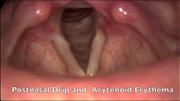

If you are unable to swallow correctly, liquids may build up in the throat, feeling like postnasal drip. In some cases, the problem is not the rate at which the mucus is produced, but rather the inability to clear the mucus away effectively. Fumes from chemicals, perfumes, cleaning products, smoke, or other irritants.

Certain foods (for example, spicy foods may trigger mucus flow) The most obvious sign of post-nasal drip is the feeling of mucus gathering in your throat or draining from the back of your nose along the back of your throat.Changing weather fronts, cold temperatures, or excess dryness in the air.Deviated septum (abnormal placement of the wall that separates the two nostrils) or another anatomical problem that affects the sinuses.Certain medications (including some birth control pills and blood pressure medications).Object stuck in the nose (more common in children).Sinus infection or sinusitis (inflammation of the sinuses).Allergies (called allergic postnasal drip).Mucus can exit the body through the front of the nose in the form of a runny nose, or it could run down the back of the nose to the throat, which is known as postnasal drip.Įxcess mucus that triggers postnasal drip can be caused by the following: You may only begin to notice this mucus when it is thicker than usual, as this is when your body produces more mucus than normal. This mucus usually goes unnoticed, because it is mixed with saliva and drips harmlessly down the back of your throat, and is then swallowed gradually throughout the day. This substance is known as mucus, which helps to trap and destroy foreign invaders like bacteria and viruses, before they enter your body and cause illnesses and infections. Sinusitis.Glands in the lining of your nose, throat, airways, stomach and intestinal tract produce a thick, wet substance that moistens these areas. doi:10.1007/s1207-3Īmerican Academy of Allergy Asthma & Immunology. Correlation study between nasal septal deviation and rhinosinusitis. Prasad S, Varshney S, Bist SS, Mishra S, Kabdwal N. Patient education: nonallergic rhinitis (runny or stuffy nose.) Swallowing problems increase risk of death, nursing home admissions. Common signs and symptoms of chronic sinusitis with nasal polyps include: A runny nose. Regardless of your choice of CPAP mask, sinus congestion can occur. School of Medicine and Public Health University of Wisconsin-Madison. Multiple growths or a large polyp may block your nasal passages and sinuses. Those that are new to CPAP therapy commonly report side effects like a sore throat, mucus in their throat, post-nasal drip, runny nose, and clogged ears after using their CPAP machine.

International Foundation of Gastrointestinal Disorders. While postnasal drip is often associated with head colds, there are myriad other possible causes: allergies, cold temperatures, bright lights, certain foods/spices, pregnancy, and other hormonal changes, to name a few. International Foundation for Gastrointestinal Disorders. Patient education: allergic rhinitis (beyond the basics).Ĭenters for Disease Control and Prevention. Post-nasal drip.Īsthma and Allergy Foundation of America. American Academy of Otolaryngology–Head and Neck Surgery Foundation.


 0 kommentar(er)
0 kommentar(er)
